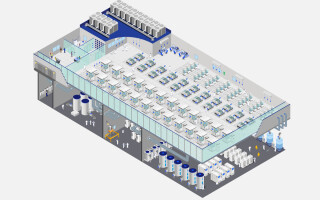Remote Service is the Latest Competitive Frontier for Medical Device Manufacturers
December 14, 2020
Story

When system uptime is everything, embracing a remote diagnostics strategy is a competitive necessity.
When system uptime is everything, embracing a remote diagnostics strategy is a competitive necessity. It is also a bold undertaking, keeping management and engineering teams stepping cautiously, yet open to service partnerships and strategies that can raise their stature as service provider. Collaborating to transform processes may be an uncomfortable task, but it is a vital step in ensuring maintenance processes are efficient, compliant, and designed for longevity. Offering service also provides opportunities – to differentiate an OEM from the competitive field, develop new revenue streams beyond delivering a system, and keep partners and customers happy and supported.
What steps are necessary in designing remote service models, and as importantly, how can manufacturers define success? A stepped approach, illustrated by one manufacturer’s real-world experience, removes the fear, sets expectations, and positions leaders for long-term rewards.
Start here: carefully observe the reliability of your products
When a device fails or falters in its performance, it may be assumed that simply replacing the industrial computing system behind the device is the smart path, the one that provides ideal service to the end-user customer. However, in the era of service as a differentiator, replacing without investigating the problem more deeply can have the opposite effect. Additional system performance issues can spike, quickly elevating customer discontent. Manufacturers should instead carefully observe and evaluate their operations: can smarter services be integrated, and what role do replacements play in increasing cost, inefficiency, and damage to OEM reputation?
This shift in handling can be demonstrated by a healthcare industry leader’s experience. The firm offers a range of surgical equipment, with its flagship platform approaching 14 years deployment on the global healthcare landscape. Reports of system sluggishness were quickly deemed temperature related, validated by the OEM’s service partner, the supplier of the device’s industrial compute system. After a decade in the field, the system’s comparatively inexpensive fan was overworked and creating impact on the CPU itself. Fans were subsequently replaced in all systems, a service easily added to every routine service call. By proactively replacing this low-cost part, the healthcare OEM preserved its service reputation and averted the risk of larger and more costly failures in the future.
Rate responsiveness and ease of access to support
Manufacturers must rate themselves critically. Routine service reviews should include customer follow ups and consider part availability, as poor handling of either of these can greatly add to customer dissatisfaction. The resulting score should focus not only on physical repair operations, but also the organization’s personal and hands-on quality of service. First, can customers easily request assistance? Second, is there an established path to diagnose and service equipment? Without addressing both of these factors, even simple maintenance may not always be simple. Yet, they are also issues easily ignored, as medical manufacturers appropriately focus attention on their instruments rather than the computers that drive them. After systems are deployed, there is much less control over service methods.
To stem the potential to be perceived as nonresponsive, and risk overcomplicating simple maintenance, our example healthcare OEM worked in tandem with its manufacturing partner. Together they established clear diagnostic protocols. Test packets are run on-site at the repair depot under guidance from the manufacturers, and repairs are verified successful before systems can be return shipped to end-users.
Look at big picture costs including the not-so-obvious
Fixed costs such as inventory and equipment, and variable costs like travel and salaries, must be factored into service strategies. This can be a deep evaluation, for example including not just tools but also their care and calibration, and not only training but also career paths for valued technicians. Taking the time with this assessment is a worthwhile exercise that is critical to building an effective service organization based on clear insights and the ability to handle costs that may increase with the urgency of service requests.
Our example organization needed to re-image and maintain patches on more than 3,000 active devices globally. Considering that each routine service trip could cost as much as $1,800, the manufacturer was inspired to work toward cost reduction. Building on successes, including the winning program of proactive fan replacement, as well as its more effective and streamlined repair depot, the firm took concrete steps to aggressively address soaring service costs.
As many as 50% of the organization’s field repairable systems were being returned to end-users noted ‘no problem found.’ This is clear jeopardy, challenging the end-user’s need for repair and setting up the device for continued poor performance. This can be seen as a negative cycle sure to diminish an OEM’s reputation for reliability. A more thorough investigation of repair depot revealed the need for more defined processes, as well as testing scenarios that closely mimicked the devices’ real-world environment. On-site diagnostics were implemented, along with a connectivity framework that allowed technicians to execute test packets simultaneously on multiple devices. Once service recommendations were completed, test packets were executed again to verify successful repair.
This service strategy also contributes to the manufacturer’s long-term competitive position. By collecting performance data of every serial-numbered device repaired, the manufacturer has much greater access to performance and design insight that can drive new types of testing and development and make a tangible impact on the bottom line.
Capitalize on connectivity across the organization
Connectivity has company-wide impact. Make sure all production manufacturing groups are ready to embrace it. Team members in quality, sourcing, software engineering, and service all need to understand connectivity’s value in creating efficiency, reducing waste and costs, and maintain a standard of excellence in servicing customers.
Software issues can often be handled with remote imaging; hardware problems can benefit from remote diagnostics that pinpoint the issue and help determine next steps on a service path. The medical device itself can even be accessed through the system’s compute engine, an extended strategy that can uncover and advise handling on existing or pending issues. As manufacturers gain access to more and more performance data, hardware components can be tracked with efficiency and meaningful insight that ensures appropriate field front stock and inventory. Even obvious benefits such as avoiding routine service visits for patches and updates may resonate more deeply. For example, new career paths may emerge for field service engineers, with greater opportunity to expand skillsets and job satisfaction for the long term.
Service is a competition; get to the finish line first
With a focus on modernization, this manufacturer was able to empower a stronger competitive role in the market. Their experience demonstrates that the phased approach is critical, helping to remove the overwhelming sense of dread that often comes with transformation.
As OEMs seek new ways to support customers well beyond just delivering a system, service is increasingly a differentiator and still rare on the OEM/ODM landscape. Lowering costs and streamlining repairs are clear benefits, but so is the new service mindset that can drive the organization forward in smart, strategic ways that align with long-term growth, success, and end-user satisfaction.
About the Author
Mark Villanova, service operations manager, Dedicated Computing
Leading service operations for Dedicated Computing, Mark has more than 25 years in management with leading manufacturing healthcare corporations, and deep expertise in medical laboratory device service support worldwide. Connect with Mark via LinkedIn or [email protected].




